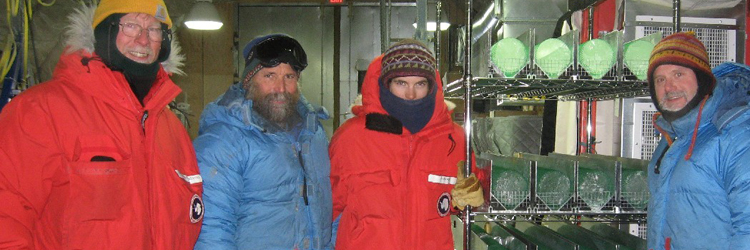News
Field and CPL Updates
2008-2009 Antarctica

Earlier this week we experienced the first break in a long stretch of stellar weather. The one and a half day storm caused moderate drifting that took a couple of days to plow out. The blowing snow required some adaptation in the drilling arch, as snow leaking in the arch interfered with the winch and cable operations. Snow can build up on cable and/or wheels to cause minute but important differences in depth, based on cable payout. Remedies included erecting a tarp over the winch, and clearing snow/ice from critical areas.
A minor emergency occurred earlier in the week when the heater for the control pendant of the gantry crane in the core processing arch over heated and rendered the crane inoperable. After consulting schematics and contacting the factory, a new control box was built on site from spare parts found locally and in McMurdo. The crane was down for only a 2 day period and is completely operable now. Matthew K. is assisting in acquiring a new factory-pendant to be sent down just in case, or as a spare. The most significant problem we have faced with the drill this season came only hours after Ken Taylor departed. Both the cutter and pump motors quit down hole and would not restart. With the motor section removed they found soot and charred material at the wiring connections on the drill fluid side compensator piston. After much diagnosis, they determined that water had been present in this enclosed area allowing the 300 volt lines to the motors to arc between connector pins. The source of the increased conductivity of the fluid is hypothesized to be ice chips + heat from the motors and/or ethanol to generate water. The solution was to put the electrical connectors on the drill fluid side of the compensator piston in epoxy to insulate them. The second part of the fix was to prevent ice chips from entering this area. This was done by replacing the breather hole with a sintered bronze breather plug and taping closed an opening used to view the oil level in the motor section. The epoxy needed to cure over night, so second and third shifts took this time as their "Sunday" off. On Saturday morning the drill was reassembled and has been performing beautifully ever since. A giant thanks goes out to the amazingly talented ICDS crew who put in heroic efforts around the clock to diagnose and remedy the problem in a truly professional manner. Because of this lost time we continued drilling on Sunday, with volunteer crews and we are now back on schedule.
Drilling depth: Currently ~ 1,175 meters, and core continues to be brittle, with average quality of fair to good. Netting is essential for maintaining core integrity, and is working well. Runs are typically 2.5 meters, and our current production rate is 36 meters per day. At this rate we should be able to reach 1,500 meters by our drilling stop date of January 23rd.
Passenger movements: Ken Taylor departed WAIS Divide Jan 8, 2009. Kelly Jacques, the Environmental Representative from McMurdo, arrived for site visit, along with two RPSC employees (Welder Doug Mettlach and GA Nick Romano).
Other activities: Anais Orsi finished up logging borehole temperatures on WDC05A. And after much digging Anais and John Fegyveresi successfully recovered boreholes WDC05B (no casing- will be lost) and WDC05C (w/ casing to be extended). This week saw the arrival of the CReSIS team (I-188 and I-205 Sridhar et al.) who report great success with both seismic and radar work. Brian Bencivengo and Bruce are now preparing for end of season, making small improvements in the coring arch, strengthening tables, re-arranging and making inventories. The D4 caterpillar is currently down with a cracked frame. Welding repairs are underway and it is expected to be in service in 3 days time. A single Cat 225 kw generator now powers all of camp. We currently have approximately 1+ weeks supply of fuel, and tanker flights are expected this week.
As if to compensate for the drama and stress of the past few days, today the camp put on a light hearted Sunday after lunch coffee-house style talent show. We all knew this place had an amazing crew, but never realized the true extent of their talents. Spirits are high, and camp is doing well.
Cheers,
Bruce

